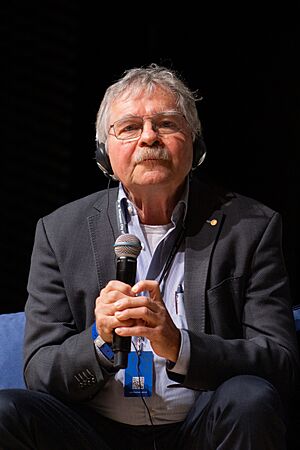Georg Bednorz facts for kids
Quick facts for kids
Johannes Georg Bednorz
|
|
|---|---|

Bednorz in 2013
|
|
| Born |
Johannes Georg Bednorz
16 May 1950 Neuenkirchen, North Rhine-Westphalia, West Germany
|
| Nationality | German |
| Known for | High-temperature superconductivity |
| Awards | Marcel Benoist Prize (1986) Fritz London Memorial Prize (1987) Nobel Prize in Physics (1987) EPS Europhysics Prize (1988) |
| Scientific career | |
| Fields | Physics |
| Thesis | Isovalent and heterovalent ionic substitution in SrTiO3 (1982) |
| Doctoral advisor | Heini Gränicher, K. Alex Müller |
Johannes Georg Bednorz is a German physicist born on May 16, 1950. He is famous for discovering "high-temperature superconductivity" in ceramic materials. He made this amazing discovery with his colleague, K. Alex Müller. For their groundbreaking work, they were awarded the 1987 Nobel Prize in Physics.
Contents
Early Life and Education
Johannes Georg Bednorz was born in Neuenkirchen, a town in North Rhine-Westphalia, Germany. He was the youngest of four children. His father, Anton, was an elementary school teacher, and his mother, Elisabeth, taught piano. His parents originally came from Silesia in Central Europe. They had to move west during the difficult times of World War II.
As a child, Johannes's parents wanted him to enjoy classical music. However, he was more interested in hands-on activities. He loved working on motorcycles and cars. Later, as a teenager, he did learn to play the violin and trumpet. In high school, he became very interested in science. He especially liked chemistry because he could learn by doing experiments.
In 1968, Bednorz started studying chemistry at the University of Münster. He soon felt that the large number of students made it hard to learn. So, he decided to switch to a less common subject: crystallography. This field combines parts of mineralogy, chemistry, and physics.
Discovering His Path
In 1972, his teachers helped him get a summer job at the IBM Zurich Research Laboratory in Switzerland. This experience was very important for his future career. There, he met K. Alex Müller, who was the head of the physics department. He also loved the creative and free atmosphere at the IBM lab. He often said this lab greatly influenced how he did science.
After another visit in 1973, he returned to Zurich in 1974. He spent six months there doing experiments for his diploma work. During this time, he grew crystals of a ceramic material called SrTiO3. This material belongs to a group known as perovskites. Müller, who was also interested in perovskites, encouraged him to continue his research.
After getting his master's degree from Münster in 1977, Bednorz began his PhD studies. He went to the ETH Zurich (Swiss Federal Institute of Technology). His supervisors were Heini Gränicher and Alex Müller. In 1978, his future wife, Mechthild Wennemer, joined him in Zürich to start her own PhD. They had met earlier in Münster.
Breakthrough in Superconductivity
In 1982, after finishing his PhD, Bednorz started working at the IBM lab. He joined Müller's ongoing research into superconductivity. Superconductivity is a special state where certain materials can conduct electricity with zero resistance. This means electricity can flow through them without losing any energy.
In 1983, Bednorz and Müller began carefully studying the electrical properties of ceramics. These ceramics were made from transition metal oxides. In 1986, they made a huge discovery! They managed to make a material called lanthanum barium copper oxide (LaBaCuO, or LBCO) superconductive.
A Record-Breaking Discovery
The amazing part was the temperature at which LBCO became superconductive. This is called its "critical temperature" (Tc). For LBCO, it was 35 Kelvin (K). This was a big deal because it was 12 K higher than the previous record! This discovery sparked a lot of new research around the world. Scientists started looking for other materials that could become superconductive at even higher temperatures. This led to the discovery of other compounds like BSCCO (with a Tc of 107 K) and YBCO (with a Tc of 92 K).
In 1987, Johannes Bednorz and K. Alex Müller were jointly awarded the Nobel Prize in Physics. They received it "for their important break-through in the discovery of superconductivity in ceramic materials." In the same year, Bednorz was also named an IBM Fellow, which is a very high honor at IBM.
Awards and Recognition
Johannes Bednorz has received many awards and honors for his important work. These include:
- Marcel Benoist Prize (1986)
- Thirteenth Fritz London Memorial Award (1987)
- Dannie Heineman Prize of the Göttingen Academy (1987)
- Robert Wichard Pohl Prize (1987)
- Otto Klung Prize (1987)
- Nobel Prize for Physics (1987)
- Hewlett-Packard Europhysics Prize (1988)
- James C. McGroddy Prize for New Materials (1988)
- Minnie Rosen Award (1988)
- Viktor Mortiz Goldschmidt Prize
- Honorable member of the Swiss Physical Society since 2011
- National Academy of Sciences foreign associate (2018)
See also
 In Spanish: Johannes Georg Bednorz para niños
In Spanish: Johannes Georg Bednorz para niños

